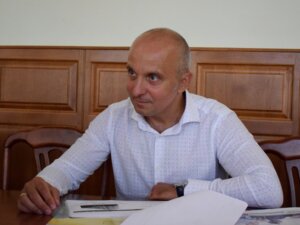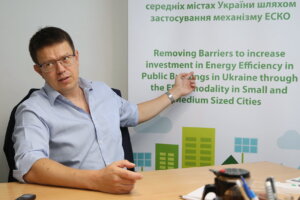Decades of access to cheap energy resources have played a dirty trick on Ukraine — the country was built in expectation of low prices. That isn’t the case anymore.
When Ukraine gained its independence in 1991, the country also lost direct access to the tremendous energy resources of Russia. Gas and oil from Russia now grew ever more expensive for Ukraine. Meanwhile, investments in energy efficiency lagged.
Because Russia uses energy supplies as both a source of revenue and a tool of geopolitical pressure, Ukraine’s political independence increasingly depends on its energy independence. Its energy independence, in turn, depends not only on diversifying the sources of energy, but also on efficient consumption.
Some experts argue that energy efficiency is even more important than diversification. But it takes tremendous efforts by local players and the international community to overcome Ukraine’s legacy of energy-intensive production and inefficient usage in all spheres of life.
“We need to run, and understand that this is a long-distance run,” says Oleksandr Kharchenko, director of Energy Research Center in Kyiv, to stress the urgency and difficulty of this issue. “A similar program completed in East Germany after unification took 18 years to finish.”
Bad, timely news
Currently, Ukraine uses two to three times more resources to produce the same unit of output than many other economies. That ratio is rising due to aging buildings, infrastructure and factories.
The lack of investment in energy — including in efficient use — is the cause of this problem. Ideally, Ukraine should invest three to four times more in the energy sphere. In particular, that money should be invested in the housing stock, state-owned buildings like university campuses, municipal buildings and infrastructure, and industry.
Energy is already used quite efficiently in transport.
“About five or 10 years ago, people were thinking less about decreasing their payments through rational consumption than through (lower) prices for energy sources,” says Serhiy Savchuk, chairman of the State Agency for Energy Efficiency. “Car owners were quicker to understand this, and not the consumers of electricity or heat-related energy. This is, first of all, because nobody subsidizes gasoline and diesel in this country. The market prices work.”
Companies have also been quick to realize the need for energy efficient production, and they have followed car owners’ suit. But publicly owned buildings and private residences lag behind in terms of energy modernization.
In fact, the population enjoys lower natural gas prices in Ukraine than do companies. The low prices for natural gas make people reluctant to modernize the heating and insulation systems in their dwellings. At the urging of donors like the International Monetary Fund and the World Bank, the government of Ukraine is gradually decreasing the difference between gas prices for companies and the population.
Help from abroad
Ukraine is not alone in facing down the mammoth task of improving energy efficiency. Many international development organizations provide the country with the necessary know-how, financing and other kinds of support.
German and Swiss development agencies are pooling their resources to promote energy efficiency in Ukraine. German international aid to Ukraine includes projects addressing the energy efficiency of Ukrainian municipalities, enterprises, and the construction of new buildings. The Swiss helped create the “Warm Loans” program run by Savchuk’s agency.
“During the last five years, we have taught people that they should consume less (energy) in their homes. On the one hand, the government has gradually stopped subsidizing heating, electricity and gas. And on the other hand, the government has created certain instruments so that people obtain the financial opportunity to decrease consumption. In particular, this is the ‘Warm Loans’ program,” he says.

Serhiy Savchuk, chairman of Ukraine’s State Agency for Energy Efficiency, talks to Kyiv Post in his office in Kyiv on July 31, 2019 (Courtesy).
By now 650,000 Ukrainian families have benefited from the program, which provides loans to households and unions of apartment owners living in the same building. The loans are for projects improving insulation, heating and other energy efficiency measures. Ukraine’s energy efficiency agency, acting on the government’s behalf, runs the project through four state-owned banks.
After a union of flat owners takes out the loan, the government — and possibly even the local authorities — will cover a significant portion of the loan. Such compensation makes “Warm Loans” palatable even for retirees, who often struggle to get by on small pensions.
The 2019 budget for the “Warm Loans” program amounts to Hr 780 million ($31 million).
Private, public buildings
Ricardo Kuelheim works at the Kyiv office of GIZ, the German international cooperation organization, on improving the energy efficiency of Ukrainian municipalities and protecting the environment through the energy efficiency of enterprises.
He says that Ukraine’s progress in energy efficiency should be compared to the Visegrad Group of Czech Republic, Hungary, Poland and Slovakia — all post-Socialist states that are now European Union members.
“The disparity between the energy efficiency levels of Ukraine and these countries is rather high,” says Kuelheim. “I think that (the consumption of energy per unit of output) is three time higher than in the Visegrad Group.”
This tendency also extends to greenhouse gas emissions: Ukraine’s emissions per unit of production are three to four times higher than in Visegrad, Kuelheim adds.
“So, it’s quite an emission- and energy-intensive economy. And this is basically the grounds for our support, specifically from the German government,” he says.
Now Kuelheim is running the second consecutive energy efficiency program in Ukraine aimed at municipalities. The first one concentrated on big cities, and the current one works with towns and smaller cities all around Ukraine. Ukrainian municipalities hold around 100,000 energy-inefficient buildings that need to be modernized. Most of these buildings are managed by municipalities, and thus it is strategically important to provide towns and cities with the necessary know-how.
The current project works with over twenty municipalities, which were chosen through a transparent selection process. The program identifies energy efficiency measures for public buildings, street lighting, and other sources of consumption. Finally, the municipalities learn to prioritize the measures to “achieve higher goals” in energy efficiency, Kuelheim says.
GIZ has also decided to implement two hardware projects on enhancing the energy efficiency of hospitals. For that purpose, GIZ ordered energy audits of 17 hospitals in Sumy and Chernihiv. Both cities are regional centers in Ukraine’s north-east. With the energy audits results in hand, the hospitals will be able to implement low-budget energy modernization measures by themselves.
Then, GIZ selected two hospitals to modernize their energy systems and set an example.
Modernization
The United Nations Development Program in Ukraine, or UNDP, takes care of creating instruments to drive forward energy modernization in Ukraine. One of such instruments is ESCO, which stands for “energy service company.”
ESCOs are commercial ventures with a simple business model. They evaluate, consult, and also invest their own resources in making a municipal building energy efficient. ESCOs can charge fees for advice and audits, and this is generally acceptable to all parties. But when ESCOs make investments in the efficiency of buildings, Ukrainian municipalities can grow wary.
After an ESCO makes such an investment, the company will charge municipalities 90 percent of the old energy bills for up to five years. This period is long enough to recover the investor’s modernization costs and generate a decent profit. After that, the investor departs and leaves behind a modernized building, which will be energy efficient for a decade at least.

During an interview on July 30, Sergii Varga of UNDP Ukraine explains to Kyiv Post the need for investments into energy efficiency of public buildings (Volodymyr Petrov).
UNDP’s Sergii Varga told the Kyiv Post that his project’s main idea is “to develop cities’ capacity to attract private investments” in energy efficiency. Varga concentrates his work on municipal buildings like “kindergartens, schools, policlinics, hospitals and administrative buildings.” Through promoting the ESCO mechanism, UNDP intends to “help private investments cooperate with the public sphere.”
The cities might argue that they could run energy efficiency projects themselves. But cities often lack the resources for considerable investments as well as the know-how. Varga is convinced that, due to high levels of expertise that ESCOs develop through many projects, they bring added value in the form of higher energy efficiency. And that is an urgent need.
“Heating modernization of residential and municipal systems, of the housing stock in general — including heating systems — and all connected (consumption) is an acute problem for Ukraine,” says Kharchenko. “It is not only about energy efficiency, but also about energy security.”
